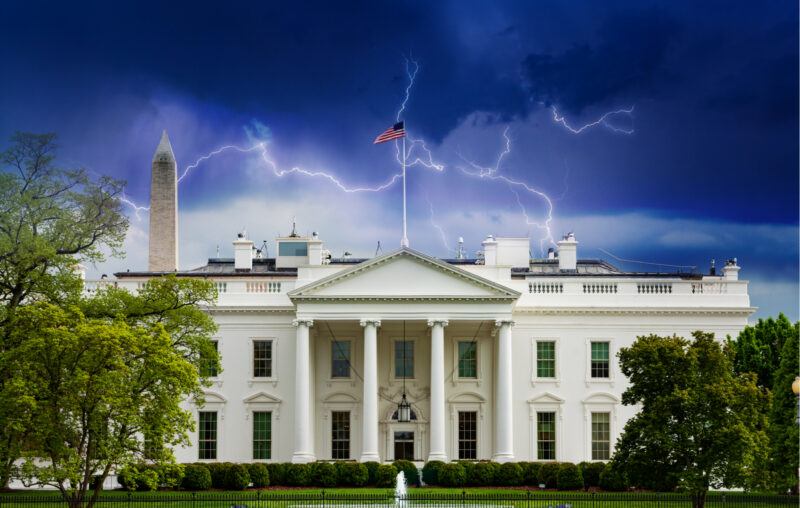No, This Was Not Federalism at Work

Imagine if one year ago U.S. states had been left free to craft fifty different responses to the rapidly spreading coronavirus. If so, it’s not unreasonable to speculate that lockdowns, to the extent that they were imposed, would have been lifted with great rapidity.
But wait, some will say, states were already autonomous.
To make their case they’ll point to April of 2020. With fear about the virus at a high, and with then-President Donald Trump having proclaimed his power over U.S. states as “absolute,” governors acted as they saw fit. Soon enough Georgia Governor Brian Kemp showed Trump where power resided by reopening the Peach State.
Notable about Kemp’s decision was how much New York Governor Andrew Cuomo disagreed. He thought Kemp, Florida Governor Ron De Santis and others were playing politics and risking death in the worst way. In Cuomo’s words, “You told the people of your state and you told the people of this country, White House, ‘Don’t worry about it. Just open up, go about your business, this is all Democratic hyperbole.” Different states, different governors, different approaches. New York remained shuttered.
Fast forward to March of 2021, and it was Texas Governor Greg Abbott who ended mask mandates in the Lone Star state. President Joe Biden famously described the lifting of restrictions as being informed by “Neanderthal thinking.” Alas Biden, like Trump, lacked the ability to force Abbott to retreat from his decision.
States’ rights at work? Fifty states operating independently, and as “laboratories” in response to the virus? On its face it sounds right, but such elation ignores what really happened.
In truth, the last year reminded us how cripplingly powerful the federal government is. Its power proved disastrous for all manner of workers and businesses.
The reality is that states weren’t nearly as autonomous as they were supposed to be. Evidence supporting the previous claim has been the lockdowns themselves. In a truly federalist system, they would have likely ended long ago.
They would have because as is well known, the states that imposed the most stringent restrictions have suffered the worst job losses, and their businesses have been impaired the most. That they’ve suffered is a statement of the obvious.
Rare is the business that can shut down, or operate at 25% capacity for even a few weeks, let alone many months. The stringent limits foisted on the citizens of blue states like California, New York and Illinois were economic death sentences of sorts, but then so were the less restrictive limits imposed by states like Texas, Florida and Georgia. To believe otherwise is to believe that pre-virus, businesses structured themselves with abundant, and unnecessary spare capacity just because, as opposed to having done so with profits in mind.
In which case it’s worth imagining what the virus response from states would have been if the federal government had for all intents and purposes done nothing out of deference to states’ rights. If so, it’s a safe bet that the response from Governors Newsom, Cuomo and Pritzker would have more resembled that of Governors Abbott, De Santis and Kemp, and that the response of the red state governors would have more resembled that of South Dakota Governor Kristi Noem, who never imposed restrictions in the first place. Absent a federal response, lockdowns of the kind Americans endured would have been an impossibility for states precisely because it was the federal government itself that subsidized the lockdowns.
Lest we forget, the federal “stimulus” response to the virus didn’t begin with President Biden’s swearing in as our 46th president. In truth it began in the spring of 2020 when President Trump signed a $2.9 trillion emergency spending bill meant to cushion the blow of massive job loss and business bankruptcy. Generous unemployment benefits and the Paycheck Protection Program (PPP) are but two examples of the federal response that made it possible for the unemployed to get by, and for dying businesses to remain afloat.
Sadly, it was never asked whether the federal government had the power to intervene so substantively in response to the coronavirus, but it’s worth asking once again what would have happened had President Trump and Republicans, often deferential to states’ rights in rhetoric, properly removed the federal government as a factor.
If so, it’s pretty safe to say that the most restrictive states would have had to end their lockdowns long ago. Really, what choice would they have had? Lockdowns of any kind of length would have resulted in unemployment and bankruptcy, and the latter would have quickly forced the hands of governors. Except that their hands weren’t forced thanks to a multi-trillion dollar federal cushion that most certainly distorted state responses. Federal meddling enabled local responses that never could have happened absent federal largess.
To which some will say thank goodness the federal government stepped in to support muscular state reactions. Lockdowns saved lives. Oh well, wise minds can debate the latter. What they can’t debate is that before the lockdowns began, Americans were already adjusting, already traveling less, eating out less, and generally being more careful. People generally don’t require state force to avoid illness or death. Since they don’t, Americans had already changed their habits substantially well before March of 2020.
Crucial about what Americans were doing is that their decisions were arrived at freely. Hundreds of millions of Americans trying different approaches to the virus. This was ideal because free people produce information about what causes a virus to spread, what behavior is most consistent with slower spread, and what’s consistent with the worst health outcomes. Applied to businesses, rather than one-size-fits all solutions, the fear that reigned in the spring of 2020 called for businesses to try different approaches, including full shutdown for some of the bigger ones that feared brand risk.
The main thing is that the lockdowns that deprived us of information, our jobs, and of economic growth were a consequence of federal action. As opposed to deferring to the states, the federal government acted in “size” fashion, thus making the life, economy and freedom-wrecking lockdowns much more stringent, all the while elongating them. When we needed the genius of states’ rights the most, panicky politicians trampled on them. Here’s hoping a strategy that was so inimical to knowledge, health and economic vitality is not attempted again.
Reprinted from RealClearMarkets










